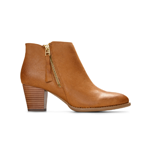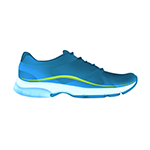
The Ultimate Guide to Finding the Best Shoes for Knee Pain

Nothing can break your stride quite like pain in your knees. Interestingly, knee pain is one of the most common pains out there—about 25% of the adult population deals with knee pain. It can come from conditions related to aging, like arthritis, or from old injuries. But did you know that the pain you feel in your knees, hips, and even your back may be coming from your feet?
Though research is still underway, there is some evidence to suggest that our feet have something to do with joint discomfort higher up our body, including in our knees.
One easy solution could be a new pair of shoes.
In this guide, we’ll briefly examine what causes knee pain and the connection between feet and knee pain, explain how proper footwear could help, and explore some of the best shoes for knee pain.
Can Knee Pain Come from Your Feet?
Our bodies are made up of complex systems. For instance, the unique skeletal and muscular structure that gives us the ability to walk upright is made up of many smaller parts working together. If one part acts out, the whole system is thrown out of whack.
Joint pain, especially in the lower body, rarely occurs in a bubble. If you’re experiencing pain in your knees without a specific injury (for example, a torn ACL), then it’s worth looking into other parts of the system to find the true problem area.
There are several ways your feet may impact (or even cause) knee pain, such as:
- Your foot shape – The shape of your foot may contribute to knee pain. For example, conditions like flat feet (where the arch in your foot never developed or collapsed due to injury) can throw off your stability and cause misalignment, which may lead to knee pain.
- Your foot in motion – Our feet strike the ground in a very particular way when we move. Some feet naturally roll outward, which is called supination. Other feet turn slightly in, known as pronation. Overpronation happens when your feet roll excessively inward rather than transferring weight into the ball of your foot as you step. People who overpronate may experience a slew of issues, including knee pain.
- Your walking gait – “Walking gait” refers to the actual motion of transferring weight from one foot to the other to move forward, backward, upward, or side to side. There’s an entire science behind the walking gait that breaks down each small movement step by step. Your gait is totally unique depending on your age, past or current injuries, medical conditions, life stages (pregnancy, for example), and even your mood. A healthy gait can support an overall healthy lifestyle. However, if there’s an imbalance somewhere along the way, it can throw off your entire alignment, causing pain and discomfort all the way up your carriage.
Managing Knee Pain With Proper Footwear
There are several different ways to manage knee pain, including strengthening exercises and stretches, recovery routines including ice and heat, taking anti-inflammatory medications like Advil, and visiting a chiropractor or a massage therapist.
But what if we told you that the easiest solution may simply be a change in footwear?
Shoes protect our feet from the outside world, but they can also provide the additional support, structure, and cushion we need to feel our best during any activity. The right pair of shoes can help correct alignment issues, guiding you on how to reduce knee pain effectively.
To that end, there are a few key features to look for when picking out the best shoes for knee pain.
Start With the Right Fit
A pair of orthopedic shoes can support your entire body, offering balance and well-being with every step. However, your shoes won’t do any good if they don’t fit properly, so start by measuring your feet and identifying your foot strike (i.e. do you supinate or pronate when you walk). You can measure your feet at home with a piece of paper, a pencil, and a flat surface, or visit a podiatrist (a foot doctor) for assistance.
Here are a few additional tips for measuring your feet correctly:
- Measure your feet in the evening – Walking around all day can increase circulation in your feet, causing them to swell. Measuring your feet after a day of walking will help you get a more accurate picture of your shoe size.
- Go with the larger size – It’s normal to have one foot larger than the other, so buy shoes that fit the bigger foot. Going up half or a full size will also help you accommodate for the kind of socks you like to wear.
- Check the width of your foot – You may be wearing shoes that are the right length, but what about shoes that are the right width? A wider pair of shoes may give your feet the relief they need.
The Importance of Arch Support and Cushioning
Our feet and knees are designed to absorb the force of our stride, which can be as much as five times our body weight. Picking shoes with proper arch support and sufficient cushioning can help with stability and weight distribution. Let’s break down each of these features:
- Arch support – The arch of your foot is made up of several tendons and ligaments crisscrossing between the bones of your feet. This spot in your foot acts as a shock absorber and helps distribute your weight from the heel to the ball of your foot as you walk. Whether you have arch-related issues or not, shoes designed with full underfoot contact reduce stress on the knee and other joints.
- Cushioning – When browsing for the best shoes for knee pain, choose a shoe with responsive cushioning, or the kind of cushion that gives energy back to you as you move. You’ll know it’s a responsive shoe if it feels springy under foot.
Top Vionic Styles for Knee Pain
There’s a stereotype that orthopedic shoes lack a sense of style and look, well, unappealing. But just because you need extra support doesn’t mean you can’t have a classy, cute, or edgy pair of kicks. At Vionic, we pride ourselves on combining supportive technology with silhouettes you know and love. From slip-on sandals to office loafers, high heels to walking sneakers, Vionic’s collections span every occasion and every mood.
Let’s go over some of the most popular categories of shoes available at Vionic.
Walking Shoes
Whether you work on your feet all day or love a walking tour in a foreign land, the best walking shoes give you the stability and support you need to go, go, go. Our tried-and-true 23Walk 2.0 Classic Sneaker comes in a variety of colors and offers legendary durability. And when the day is done and it’s time to kick back, give your feet a little R&R with a recovery shoe like the Tide RX Recovery Sandal (or a pair of luxuriously soft slippers, like the Relax II Slippers).
Office Shoes
Are your fancy office shoes getting you down? We understand your plight. That’s why we paired our Vio-Motion Technology with the most classic business casual footwear, like our Willa Slip On Flat, our Uptown Loafer, and our ultra-stylish Fillmore Lug Loafer.
Athletic Shoes
Movement (whatever that means to you) is an important way to stay healthy, both physically and mentally. So, whether you enjoy lifting weights or are super into power walking, you’ll need a solid pair of shoes to help maintain alignment and offer extra support. The best athletic shoes for knee pain offer ample cushioning for shock absorption, a deep heel cup for stability, and good arch support for balance and proper weight distribution. Go technical with Vionic’s Walk Strider Sneaker or the Walk Max Lace Up Sneaker.
Casual Sneakers
If you’re looking for a go-to pair of casual sneakers that go with every outfit, then Vionic has you covered. From the classic low-top style of the Lucas II Lace Up Sneaker to the fun and frisky Winny Sneaker, your sneaker game can stay sharp (and comfortable at the same time).
Sandals
Summertime means letting the toes breathe. But traditional flip-flops or slide-on sandals offer very little support and can wreck your feet. We’ve given these wardrobe staples a major upgrade with structure and arch support designed for all-day wear. See for yourself by checking out Men’s Tide II Toe Post Sandal and the Bella Toe Post Sandal.
Insoles
Have a favorite pair of shoes that need a little extra cushion? Bring Vionic technology to any shoe with our Men’s Relief Insoles and Women’s Relief Insoles, guaranteed to provide day-long comfort for any activity you engage in.
Discover Supportive, Stylish Shoes from Vionic
When you understand how the human body is built, it makes sense that instability in the feet may impact other joints, including the knees. Fortunately, by investing in the best shoes for knee pain, you can ensure all-over comfort and total well-being.
Discover whole-body balance with Vionic.
Our Vio-Motion Technology focuses on biomechanics to provide exclusive alignment, durability, and support in every style. Shop our collections today to find your new favorite (and ultra-supportive) shoes.
Sources:
PubMed from NCBI. “Knee Pain in Adults and Adolescents: The Initial Evaluation.” https://pubmed.ncbi.nlm.nih.gov/30325638/
NCBI. “Flat Feet Are Associated With Knee Pain and Cartilage Damage.” https://www.ncbi.nlm.nih.gov/pmc/articles/PMC3087845/
University of Rochester Medical Center. “Are Feet at Fault for Back, Hip, and Knee Woes?” https://www.urmc.rochester.edu/encyclopedia/content.aspx?ContentTypeID=1&ContentID=1158
Cleveland Clinic. “Overpronation.” https://my.clevelandclinic.org/health/diseases/22474-overpronation
Healthline. “10 Visuals of Exercises to Help Relieve Knee Pain.” https://www.healthline.com/health/exercises-for-knee-pain
OrthoFeet. “What are Orthopedic Shoes and Why You Should Wear Them.”
https://www.orthofeet.com/blogs/news/why-are-orthopedic-shoes-the-best-type-of-footwear
Mind Body Green. “10 Best Shoes for Knee Pain, Recommended by Podiatrists.” https://www.mindbodygreen.com/articles/best-shoes-knee-pain
Runner Click. “What Exactly is Responsiveness?” https://runnerclick.com/what-exactly-is-responsiveness/










